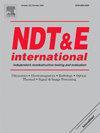脉冲压缩瑞利波emat的改进
IF 4.1
2区 材料科学
Q1 MATERIALS SCIENCE, CHARACTERIZATION & TESTING
引用次数: 0
摘要
超声瑞利波因其对表面缺陷的高灵敏度而在无损检测中发挥着关键作用。曲线线圈式电磁声换能器(EMATs)可以在不接触试样的情况下有效地激发瑞利波。近年来,脉冲压缩技术(PCT)被引入瑞利波emat中,以获得尖峰状信号,显著提高了对相邻缺陷的检测能力。然而,接收信号的小幅度限制了PCT在瑞利波emat中的实际应用。为了提高信号幅值,本文首先用解析模型分析了脉冲压缩emat的工作原理。接下来,我们提出了利用脉宽调制(PWM)的弯曲线线圈的设计方法,并通过改进的空间脉冲压缩(SPC)技术验证了PWM线圈的性能。然后,提出了时空脉冲压缩(TSSPC)方法,利用时间反转法设计的提取信号进一步提高振幅。在此基础上,设计了一个数字匹配滤波器作为接收信号的附加增益,即时空脉冲压缩(TSSTPC)技术。最后,通过实验验证了上述PCT瑞利波emat的有效性。研究发现,与之前的SPC相比,本文提出的改进SPC、TSSPC和TSSTPC分别提高了11.3 dB、23.7 dB和24.7 dB的接收信号。本文章由计算机程序翻译,如有差异,请以英文原文为准。
Improvement of pulse compression Rayleigh-wave EMATs
Ultrasonic Rayleigh waves play a key role in the non-destructive testing due to their high sensitivity to surface defects. Meander-line coil electromagnetic acoustic transducers (EMATs) can efficiently excite Rayleigh waves without contacting the specimen. Recently, the pulse compression technique (PCT) has been introduced to Rayleigh-wave EMATs to obtain spike-shaped signals, significantly improving the detection capability of adjacent defects. However, the small amplitude of the received signal limits the practical application of PCT in Rayleigh-wave EMATs. In order to enhance the signal amplitude, the principle of pulse compression EMATs is firstly analyzed using an analytical model in this paper. Next, we propose the design method of meander-line coils utilizing pulse-width modulation (PWM), and the performance of PWM coils is confirmed through the improved spatial pulse compression (SPC) technique. Then, the temporal-spatial-spatial pulse compression (TSSPC) is proposed to further increase the amplitude with the exaction signal designed by the time reversal method. After that, a digital matched filter is designed as an additional gain to improve the received signal, which is temporal-spatial-spatial-temporal pulse compression (TSSTPC) technique. Finally, the effectiveness of the above PCT Rayleigh-wave EMATs are verified by experiments. It is found that, compared with the previous SPC, the received signals in improved SPC, TSSPC and TSSTPC proposed in this paper are increased by 11.3 dB, 23.7 dB and 24.7 dB, respectively.
求助全文
通过发布文献求助,成功后即可免费获取论文全文。
去求助
来源期刊

Ndt & E International
工程技术-材料科学:表征与测试
CiteScore
7.20
自引率
9.50%
发文量
121
审稿时长
55 days
期刊介绍:
NDT&E international publishes peer-reviewed results of original research and development in all categories of the fields of nondestructive testing and evaluation including ultrasonics, electromagnetics, radiography, optical and thermal methods. In addition to traditional NDE topics, the emerging technology area of inspection of civil structures and materials is also emphasized. The journal publishes original papers on research and development of new inspection techniques and methods, as well as on novel and innovative applications of established methods. Papers on NDE sensors and their applications both for inspection and process control, as well as papers describing novel NDE systems for structural health monitoring and their performance in industrial settings are also considered. Other regular features include international news, new equipment and a calendar of forthcoming worldwide meetings. This journal is listed in Current Contents.
 求助内容:
求助内容: 应助结果提醒方式:
应助结果提醒方式:


